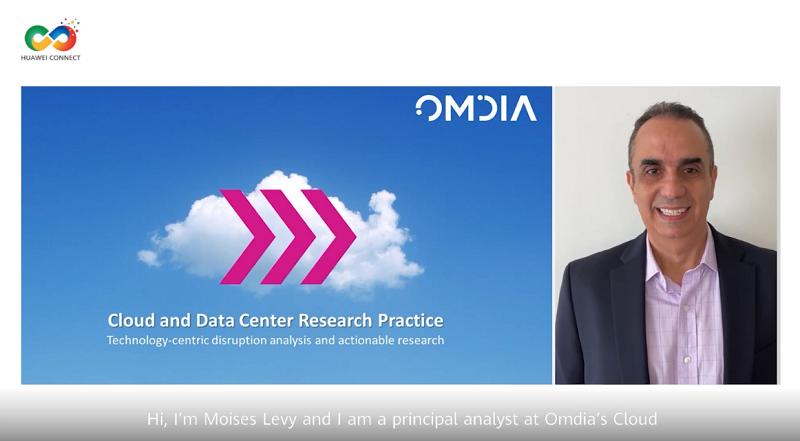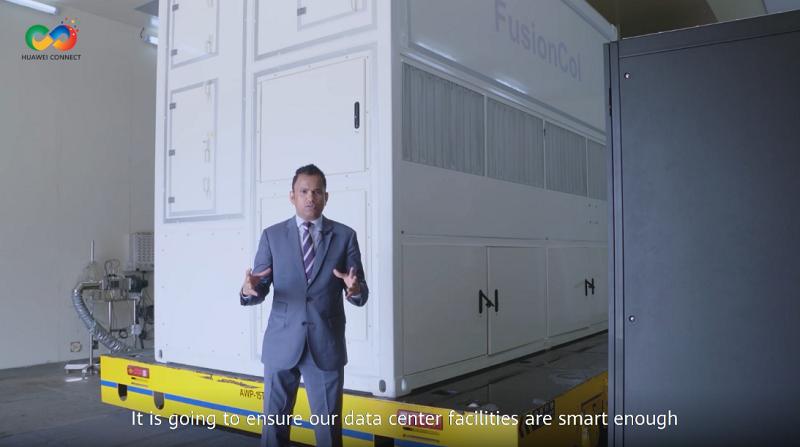
Huawei Launch Next-Generation Indirect Evaporative Cooling Solution at HUAWEI CONNECT 2021
[Online, September 27, 2021] Huawei Data Center Facility: Toward a Green Future session was held at HUAWEI CONNECT 2021. The session conveyed new trends, solutions and real-world success in data centers. Additionally, Huawei launched Indirect Evaporative Cooling solution, an innovative, next generation solution that is designed to upgrade Air Handling Units (AHU) to Environment Handling Units (EHU), further reducing data center Power Usage Effectiveness (PUE) and embracing carbon neutrality.
Mr. Moises Levy
In a speech on Global Data Center Trends, Mr. Moises Levy, PhD, Principal Analyst, Data Center Power and Cooling, OMDIA says, “In 2020, the ICT industry agreed on a science-based target to reduce greenhouse gas emissions by 45% between 2020 and 2030. Data centers can consume 50 times more energy than a conventional office building. IT equipment by itself can consume several kilowatts and its high concentration in data centers results in higher power densities. Nowadays, we are seeing a number of initiatives improving sustainability for data centers focusing on clean technologies, renewable energy and reduction of greenhouse gas emissions. For this purpose, research and innovation from global enterprises is much needed.”
“Einstein once said, ‘Look deep into nature and you will understand everything better.’ We would like to ensure a human-like breathing effect in the data centers so that the data centers can breathe the natural cold air available to provide comprehensive cooling by relying more on natural cooling resources. This is how Huawei is going to provide the comprehensive cooling capacity that is going to ensure low power consumption and reduce carbon emissions ”, said Mr. Mahesh Krishnarao Choudhary, Senior Solution Architect Digital Power, Huawei..
The new Indirect Evaporative Cooling Solution integrates a range of technologies — such as indirect evaporative cooling, heat recovery, and mechanical cooling — optimizing the structure and size of evaporative cooling equipment in data centers. Such a high level of integration enables Huawei to provide simpler and more effective installation and operations.
Mr. Mahesh Krishnarao Choudhary
Highly Integrated, Shortening TTM
Indirect evaporative cooling installations involve air dampers, water treatment, and other cooling components that affect the entire commissioning and construction cycle. Huawei has adopted an innovative concept of cooling convergence. Based on the original design of the previous ones, the latest solution is an integrated, all-in-one system, with further optional components available including dehumidifiers, humidifiers, shutoff, and fire extinguishing dampers. This cuts down the Time to Market (TTM) by an impressive 50%.

Adding a Power Supply System to Enhance GUE
Traditionally, a data center cooling system needs to be configured with an independent Uninterruptible Power Supply (UPS), which has a large physical footprint and comes at a high cost. In addition, indirect evaporative cooling typically has higher peak power needs compared to a conventional chilled water-cooling system, resulting in lower power capacity available for IT systems, in turn negatively impacting Grid Utilization Effectiveness (GUE).
Huawei indirect evaporative cooling directly taps into the lithium battery energy storage system. In other words, the upper-level UPS is reduced and the UPS lithium battery is directly connected, simplifying power distribution links and reducing CAPEX by 10%.
This design does not only reduce electricity costs through peak-valley energy storage. It also reduces the peak power needs of indirect evaporative cooling, in turn improving GUE by more than 3%. This allows more IT cabinets to be powered, improving overall revenue.
Continuous Cooling, High Availability
In a traditional UPS solution using indirect evaporative cooling, during dual-power switchover, the compressor will restart, interrupting cooling and leading to a temperature rise in a data center.
Huawei’s indirect evaporative cooling directly supports the lithium battery energy storage system and keeps the compressor running during mains switchover. This effectively eliminates temperature fluctuations in data centers, better meeting data center availability requirements as well as Uptime Institute Tier IV continuous cooling requirements.
Intelligent, Simplifying O&M
Data center O&M is complex and there are many potential fault points, from water leaks to freezing pipes, local hotspots, and internal structural faults. Huawei’s new indirect evaporative cooling uses leading digitalization technology to replace manual inspection by predicting and self-diagnosing faults, and reducing O&M time by more than 50%.
Additionally, the intelligent era of cooling systems has now arrived. Huawei uses iCooling integrated energy efficiency optimization technology to further improve PUE and the Cooling Load Factor (CLF) under the condition that the hardware conditions remain unchanged.
As the world focuses on carbon neutrality, energy conservation, and sustainable development, the data center industry also should share these goals. Huawei is committed to ongoing innovation, with the aim of building the future of simplified, green, intelligent, and secure data center solutions.
}})